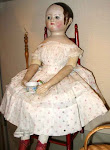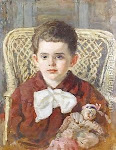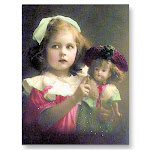

The complexities of wearing mourning dress took hold as the Victorian era progressed following the death of Prince Albert in 1861. Women bore the greatest burden of these customs. They involved wearing heavy, concealing, black clothing, and the use of heavy veils of black crêpe. The entire ensemble was colloquially known as "widow's weeds" (from the Old English"Waed" meaning "garment").
The 1894 sketch above is called For Such is the Kingdom by Frank Bramley and illustrates the custom of little children dressed in white walking in procession in front of a small white coffin containing a young person. Often four young maidens, also dressed in white attire served as pall bearers for the departed child. The custom of children wearing white to funerals continued well into the twentieth century.

Special caps and bonnets, usually in black or other dark colours, went with these ensembles. There was special mourning jewelry, often made of jet and with the hair of the deceased in a locket or brooch.


Queen Victoria wore her widow's weeds for the remainder of her long life until 1901, when the Edwardian era began. Many who saw themselves as fashionable, including those in the lower classes, followed their Queen's example.
 Framed Victorian engraving print of children mourning. By C. W. Nicholls, 1866. "Children at the Tomb of Grace Horsley Darling Lighthouse-Keeper's Daughter".
Framed Victorian engraving print of children mourning. By C. W. Nicholls, 1866. "Children at the Tomb of Grace Horsley Darling Lighthouse-Keeper's Daughter".

Widows were expected to wear special clothes to indicate that they were in mourning for up to four years after the death. To change the costume earlier was thought disrespectful to the decedent and, if the widow was still young and attractive, suggestive of potential sexual promiscuity. Those subject to the rules were slowly allowed to re-introduce conventional clothing at different time periods; such stages were known by such terms as "full mourning", "half mourning", and similar descriptions. At half mourning, gray and lavender could be introduced.


The young widow, exchanging the wedding gown for mourning.
The Victorian preoccupation with death is reflected in the art of the period. Photographs, paintings, death portraits, steel engravings, lithographs, etchings, and other art forms embraced the most sentimental and heartrending portrayals of loss and bereavement.
The Victorian preoccupation with death is reflected in the art of the period. Photographs, paintings, death portraits, steel engravings, lithographs, etchings, and other art forms embraced the most sentimental and heartrending portrayals of loss and bereavement.

Mourning Hair Ornament

During the mourning period a black edge was applied on all stationary, envelopes, notepaper and visiting cards. Prayer books and bibles had to be bound in Black morocco leather and handkerchiefs edged in black.Mourning was an expensive activity and also wasteful, because it also had to be fashionable. As normal clothes were put away they would often be out of fashion by the time mourning was over so they were sometimes remodelled and often discarded.
 " Widowed Mother and Child" Ackerman ca. 1809
" Widowed Mother and Child" Ackerman ca. 1809

Black was the chief mourning colour in the immediate months after a death for deepest mourning. Dull surfaced black fabrics such as crape, plain bombazine, paramatta, merino wool and cashmere were also favoured and used depending on income.


Formal mourning culminated during the reign of Queen Victoria. Victoria may have had much to do with the practice, owing to her long and conspicuous grief over the death of her husband, Prince Albert. Although fashions began to be more functional and less restrictive for the succeeding Edwardians, appropriate dress for men and women, including that for the period of mourning, was still strictly prescribed and rigidly adhered to. The rules were gradually relaxed, and acceptable practice for both sexes became to dress in dark colours for up to a year after a death in the family. By the late 20th century, this no longer applied. Black had been widely adopted by women in cities as a fashionable color.

During the mourning period a black edge was applied on all stationary, envelopes, notepaper and visiting cards. Prayer books and bibles had to be bound in Black morocco leather and handkerchiefs edged in black.Mourning was an expensive activity and also wasteful, because it also had to be fashionable. As normal clothes were put away they would often be out of fashion by the time mourning was over so they were sometimes remodelled and often discarded.
 " Widowed Mother and Child" Ackerman ca. 1809
" Widowed Mother and Child" Ackerman ca. 1809
Black was the chief mourning colour in the immediate months after a death for deepest mourning. Dull surfaced black fabrics such as crape, plain bombazine, paramatta, merino wool and cashmere were also favoured and used depending on income.
Animals and children were especially popular as subjects to portray pathos and grieving.


Formal mourning culminated during the reign of Queen Victoria. Victoria may have had much to do with the practice, owing to her long and conspicuous grief over the death of her husband, Prince Albert. Although fashions began to be more functional and less restrictive for the succeeding Edwardians, appropriate dress for men and women, including that for the period of mourning, was still strictly prescribed and rigidly adhered to. The rules were gradually relaxed, and acceptable practice for both sexes became to dress in dark colours for up to a year after a death in the family. By the late 20th century, this no longer applied. Black had been widely adopted by women in cities as a fashionable color.













































.jpg)























































































I'm speechless. Your blog is a dream come true, completely satisfy my morbid curiosity for everything that is Victorian!
ReplyDeleteYou are great. I guess you want a lot of patience and dedication to find all this material. I appreciate it!
A hug, Flora
Thank you Flora! I love doing the posts on Victorian England. Mourning in particular was very interesting to research. Victorians made it into an art.
ReplyDeleteBisous
Marta
Precioso, Marta.
ReplyDeleteMe ha encantado. Sé que no es una novedad, por que me encantan todas tus entradas. El tema, es fascinante, triste, pero fascinante.
Yo he vivido lo de las tarjetas y el papel de cartas con el borde en negro. Supongo que es una costumbre, la de vestirse de negro, ya en desuso por toda la gente joven, por que como tú bien dices, un vestido negro, hoy en día, es algo de moda y símbolo de elegancia.
Tengo una reproducción del cuadro de Landseer enmarcada en mi casa. me pareció precioso y muy conmovedor, cuando lo descubrí.
Gracias, Marta.
Un beso.
¿Que tal el weekend en el campo? espero que genial y placentero.
Hola Marta!!!
ReplyDeleteHoy he aprendido mucho acerca del duelo victoriano gracias a tu investigación.
Muchas gracias por compartirlo y por tan bellas imágenes.
Un abrazo!!!
Great post. I've photographed many of the Victorian cemeteries and they have an art form all of their own. Shire Books do a good small book on mourning customs. Very interesting post.
ReplyDeleteMarvelous I love love love this post and this pictures
ReplyDeletekisses from France
Thank you so much my friends, I am very moved by all your comments.
ReplyDeleteBisous
Marta
Hi Marta, That is a great post today and the victorian pictures were verry good all put together verry well. Thank You for stopping by today...Julian
ReplyDeleteQue triste|||
ReplyDeleteQue dificil superar la muerte de los seres queridos...
Hi Marta, Thank You for stopping by and I am glad you liked the oil paintings. Have a good week......Julian
ReplyDelete